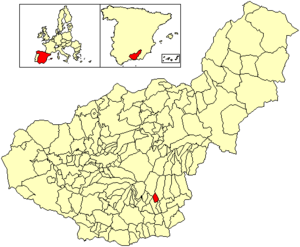Juviles facts for kids
Quick facts for kids
Juviles
|
|||
|---|---|---|---|
|
|||

Location of Juviles
|
|||
| Country | |||
| Autonomous community | |||
| Province | Granada | ||
| Comarca | Alpujarras | ||
| Judicial district | Órgiva | ||
| Area | |||
| • Total | 15 km2 (6 sq mi) | ||
| Elevation | 1,255 m (4,117 ft) | ||
| Population
(2018)
|
|||
| • Total | 142 | ||
| • Density | 9.5/km2 (24.5/sq mi) | ||
| Demonym(s) | Juvileño, -a | ||
| Time zone | UTC+1 (CET) | ||
| • Summer (DST) | UTC+2 (CEST) | ||
| Postal code |
18452
|
||
Juviles is a small village and a municipality (a type of local government area) in southern Spain. It is located in the central part of the Alpujarras region. This area is in the province of Granada.
The village sits high up, about 1,255 meters (4,117 feet) above sea level. You can find it on the road that connects the towns of Trevélez and Ugíjar. Juviles covers an area of about 12 square kilometers (4.6 square miles). In 2003, around 160 people lived there.
Contents
What Juviles is Known For
Juviles has a long history with farming. Even though less land is farmed now, it is still famous for its air-cured ham. This is similar to the ham from Trevélez, another nearby town.
Silk Production in the Past
Long ago, when the Moors lived in Spain, Juviles was an important center for making silk. This shows that the area had different kinds of industries over time.
History of Juviles
Juviles has a rich and interesting history. It played an important role in the region for many centuries.
Ancient Fortress and Its Importance
A strong fortress was built in Juviles back in the 8th century. The village itself might be even older than that. During the Middle Ages, this fortress became a very important place. It often served as a safe spot for local people when there were conflicts or fights in the area.
Changes in Power
In the year 913, a leader named Aberramán III took control of Juviles. For a long time, from the 12th to the 16th century, Juviles was the main town for a group of 12 other settlements. These settlements also had 23 smaller hamlets connected to them.
Fortress Destruction and New Settlers
After a rebellion by the morisco people (who were descendants of the Moors) around 1500, Fernando the Catholic, a king of Spain, ordered the fortress to be destroyed. This was done to prevent future uprisings. You can still see the ruins of this old fortress today.
In 1572, after the rebellion, the remaining morisco population in Juviles was replaced. New Christian families were brought in from Castile, another part of Spain, to live in the village. This was a common change in many areas of the Alpujarras region at that time.
See also
 In Spanish: Juviles para niños
In Spanish: Juviles para niños




